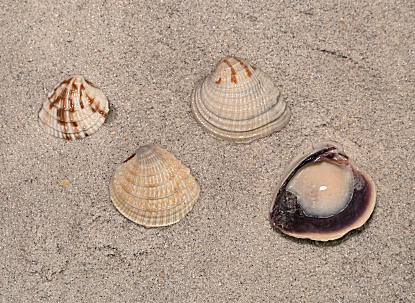
Chione elevata
These bivalves are seldom larger than 1½” and are the most numerous shells found on our beaches. As its name implies, it has raised, bladelike concentric ridges superimposed on strong radial ribs giving a lattice appearance. The hinge of the shell has two teeth and the shell edge is finely ridged.
The clam’s preferred habitat is in the sand around seagrass beds. There they consume plankton. Using a siphon system, seawater is passed over a mucus collection net extracting the food. There are approximately 23 species of the genus Chione in Florida, however the distinctive raised cross-bar pattern identifies the elevata species.
Numerous gastropods prey on the Cross-Barred Venuses, with its relatively thin shell and meaty prize inside. For us, a tasty chowder can be made, although a lot of these tiny clams are required.
Live shells should never be taken from any Florida State Park.